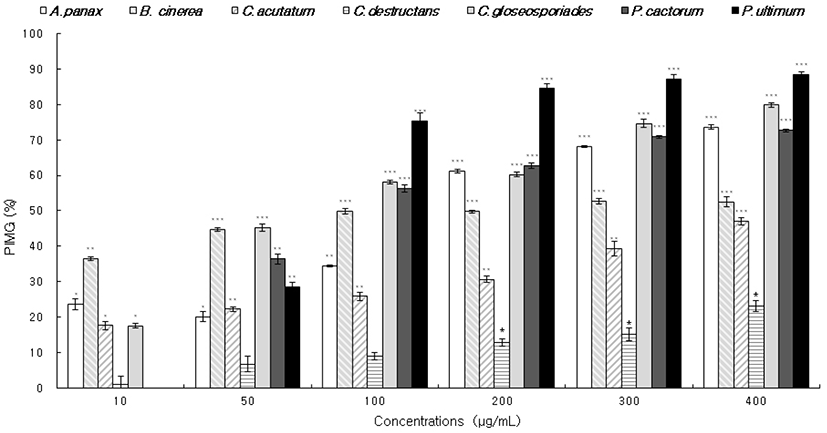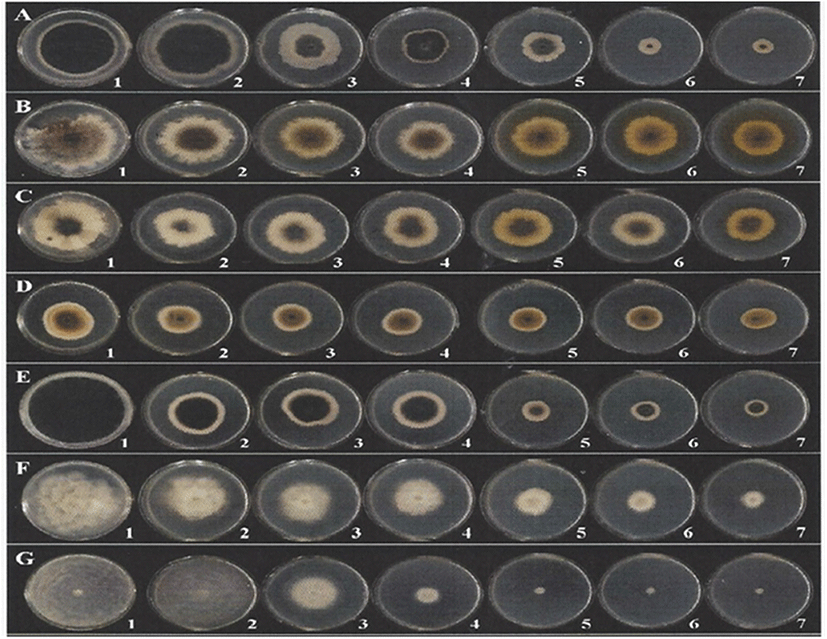1. Introduction
Insects, weeds, and phytopathogenic fungi cause significant damage to agriculture, homes, and gardens. If these are not controlled systematically, an estimated 40% of a typical crop is lost preharvest and an additional 20% is lost postharvest (Pimentel et al., 1992). Synthetic pesticides have successfully controlled numerous agricultural pests; however, the development of resistance in pests to current pesticides and high costs for the development of new chemicals limit the efficiency of synthetic pesticides. Furthermore, residues of synthetic pesticides in agricultural products threaten human health and soil and water ecosystems (Di et al., 2022; Liu et al., 2021; Wei et al., 2021). Thus, natural chemicals produced by plants (plant extracts or phytochemicals), fungi, and bacteria, which constitute a rich source of bioactive substances, may be an alternative to the currently used pesticides for controlling insect pests, phytopathogenic fungi, and mosquito larvae (Kalhoro et al., 2022; Seepe et al., 2021; Swain, 1997; Wink, 1993).
The genus Paeonia (family Paeoniaceae) is distributed throughout China, India, Japan, Korea, and Vietnam (Bich et al., 2004). The roots of Paeonia lactiflora Pall. have been frequently prescribed as an alternative medicine to enhance blood circulation and inhibit inflammation (Cameron and Cruickshank, 2007; Perrin et al., 2007; Zhang et al., 2020). However, very few phytochemical studies are available on seeds. Recently, resveratrol and its derivatives, possessing anti-carcinogenic, anti-mutagenic, and anti-oxidative activities, were isolated from Paeonia seeds (Kim et al., 2002a; Kim et al., 2002b; Wu et al., 2022). The objective of this study was to investigate fungicidal effects of the seed extract of P. lactiflora against Alternaria panax, Botrytis cinerea, Colletotrichum acutatum, Cylindrocarpon destructans, Colletotrichum gloseosporiades, Phytophthora cactorum, and Pythium ultimum and test the potential of this species as an effective and environment-friendly alternative.
2. Materials and methods
Seeds of Paeonia lactiflora were obtained from Euiseong herb experimental (Euiseong-gun, Kyungpook, Korea). 1.5 kg of the seeds was subjected to extraction with 70% methanol by shaking for 5 days, and it was subjected to further extraction three times for 12 h each. After filtration through Whatman No.2 filter paper, the extract was concentrated at 40°C using a rotary evaporator.
Seven phytopathogenic fungi (A. panax, B. cinerea, C. acutatum, C. destructans, C. gloseosporiades, P. cactorum, and P. ultimum) were donated by Korean Agricultural Culture Collection (KACC).
Potato dextrose agar (PDA) was accurately weighed and dissolved in distilled water, kept in an Erlenmeyer flask, plugged with cotton, and sterilized. After sterilization, approximately 20 mL of the agar medium was poured into sterilized Petri dishes (9 cm diameter), allowed to cool and solidify, and inoculated. Antifungal assay was performed on the solid media by disc diffusion method (Duru et al, 2003). Eight sterile Whatman paper discs (8 mm diameter) were pierced in the agar plates, equidistant and near the border, and separately loaded with 50 μL solution containing 0.05, 0.1, 0.25, 0.5, 1, 1.5, 2, and 2.5 mg of the extract each, and then dried at room temperature for 30 min.
Discs of fungal inocula, 8 mm in diameter, were collected from pre-grown cultures of each of the fungal strains to be tested and placed upside down in the center of the Petri dishes containing agar and extract discs. The plates were incubated at 28°C for 6 days. The diameter of the mycelial area was measured in each dish. An average of three measurements of diameter was considered.
Percent inhibition of mycelial growth (PIMG) assay was conducted for the quantitative analysis of the antifungal effect of P. lactiflora seed extract. Six mixtures of PDA with seed extract were prepared at concentrations of 10, 50, 100, 200, 300, and 400 μg of the seed extract/mL, respectively. After autoclaving at 121°C for 15 min, these media were poured into separate sterilized Petri dishes. Agar discs (8 mm) were taken from the fungal cultures and placed in the center of each of the Petri plates. Similarly, for control, fungal agar discs (8 mm diameter) were placed on fresh PDA plates without seed extracts. All cultures were incubated at 28°C for 6 days. Inhibitory activity was assessed by measuring the radial growth of mycelia on the treated media (R2) and radial growth on the control plates (R1), and using the formula:
The minimal inhibitory concentration (MIC) of the antifungal agents against various fungi was determined using broth micro-dilution method, as the lowest concentration at which no fungal growth was observed. 19.6 mL of potato dextrose broth medium was dispensed into 100 mL Erlenmeyer flasks and autoclaved at 121°C for 15 min. 200 μL of different doses (final concentration 2.5-500 μg/mL) of the extract were diluted in methanol and mixed separately into the liquified PDBs. The fungal inoculum (200 μL suspension, 107 spores/mL concentration) was added to each of the Erlenmeyer flasks. The tests were first performed using a high concentration of the extract, which was further diluted until no inhibitory activity was observed. Media without extract treatment were used as controls. The fungal cultures were incubated at 28°C for 7 days and observed for growth inhibition.
Flasks with mycelial growth were filtered through Whatman GF/C filter paper and washed with distilled water. The mycelia were placed on pre-weighed filter papers, were allowed to dry at 60°C overnight, and then weighed. Growth inhibition based on dry weight was calculated using the following formula;
Thermal stability of the antifungal component in the extract was determined by heating the extract at 121°C for 15 min and loading to 8 mm filter paper discs at 0.05, 0.1, 0.25, 0.5, 1, 1.5, 2, and 2.5 mg of extract/disc concentrations and dried at room temperature for 30 min. These discs were placed on PDA plates and incubated at 28°C for six days. The diameter of mycelia in each dish was measured. An average of three measurements of diameter was considered. P. cactorum was used for the thermal stability measurement.
3. Results and discussion
Antifungal activity of P. lactiflora seed extract was evaluated against seven phytopathogenic fungi using disc diffusion assay. Extract was added to discs at 0.05, 0.1, 0.25, 0.5, 1, 1.5, 2 and 2.5 mg/disc concentrations, respectively. Table 1 presents the results of the assay. An increase in the inhibition zone was observed with the increase in concentration of the extract. The seed extract showed antifungal effects against all seven phytopathogenic fungi at concentrations 1-2.5 mg/disc. Further, antifungal activity was the highest against P. cactorum and lowest against B. cinerea.
To evaluate PIMG, the extract (concentrations of 0, 10, 50, 100, 200, 300, and 400 μg/mL) was added to separate PDA mixtures and inoculated. The extract showed antifungal effects against all seven phytopathogenic fungi at concentrations 50-400 μg/mL. PIMG was the highest (88.39%) for P. ultimum at 400 μg/mL (Fig. 1 and Fig. 2).


The MIC is the lowest concentration at which the growth of target phytopathogenic fungi is inhibited. We examined the inhibitory action of the extract at 2.5-500 μg/mL concentrations against the seven phytopathogenic fungi (Table 2). The seed extract showed strong antifungal activity at 20-500 μg/mL concentrations. The MIC of the seed extract was observed at 20 μg/mL for P. ultimum and P. cactorum, 100 μg/mL for A. panax, 200 μg/mL for C. destructans and C. gloseosporiades, 400 μg/mL for C. acutatum, and 500 μg/mL for B. cinerea. Thus, the strongest inhibitory activity was observed against P. ultimum and P. cactorum. The MIC values suggest that cell growth inhibition was mediated by fungicidal action of the seed extract.
In this study, the inhibitory effect against fungi of Paeonia lacflora seed extract evaluated. It can be suggested that Paeonia lacflora seed extract contain potential antifungal compounds and the obtained results may also be useful for finding active substances. Therefore, active chemical compound of Paeonia lacflora seed extract will be further investigated in further studies.
The antifungal activity of the extract against P. cactorum (cultured for 6 days) in relation to temperature is shown in Table 3. The inhibitory effect of the extract (in terms of inhibition zone) without heat treatment was similar to that of the extract heated at 121°C for 15 min, implying that the antifungal activity of the extract was not affected by the increase in temperature. Therefore, the antifungal component of the seed extract was concluded thermostable and it is suggested that the Paeonia lacflora seed extract has stability for antifungal activity maintaining.
4. Conclusions
In this study, P. lactiflora seed extract was used to evaluate its inhibitory effect against selected phytopathogenic fungi. The seed extract showed potent antifungal activity against A. panax, C. acutatum, C. destructans, C. gloseosporiades, P. cactorum and P. ultimum. Further, antifungal activity was the highest against P. cactorum and P. ultimum. These results suggest that P. lactiflora seed extract may be effective for management of numerous plant diseases by reducing the effects of pathogenic fungi.
